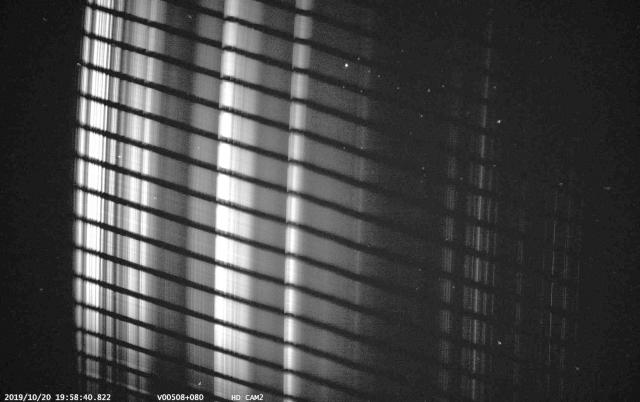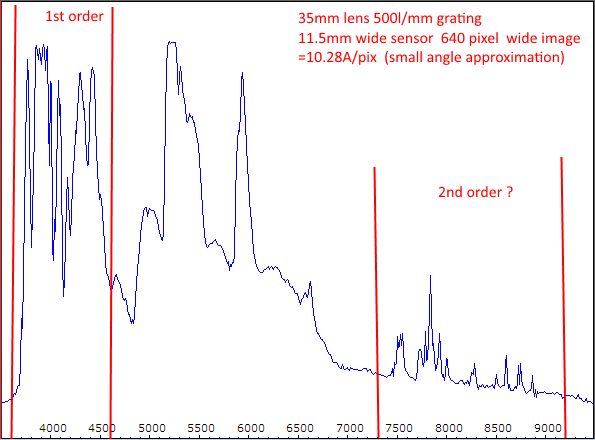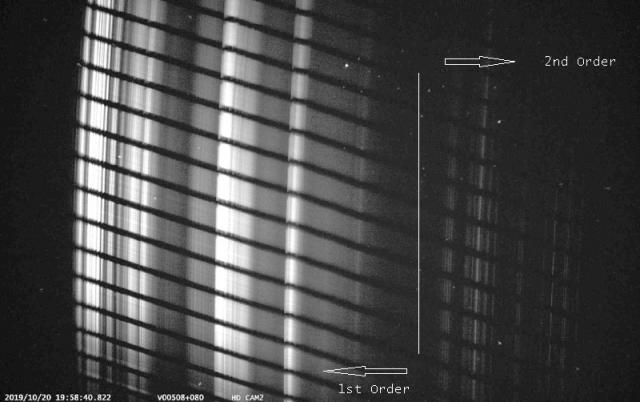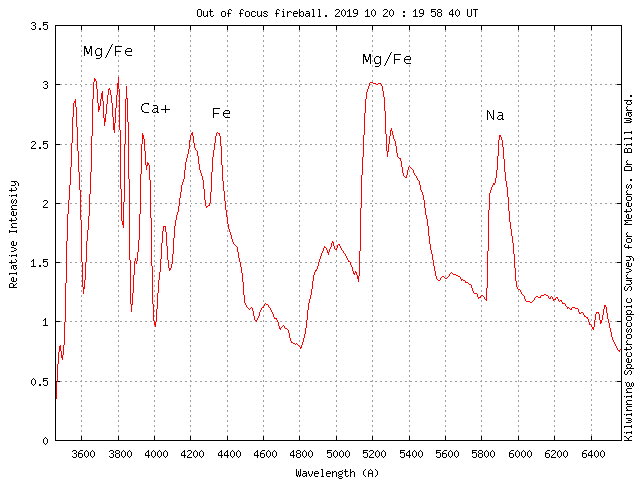- This topic has 17 replies, 5 voices, and was last updated 4 years, 4 months ago by
 Bill Ward.
Bill Ward.
-
AuthorPosts
-
21 October 2019 at 12:17 am #574431
 Bill WardParticipant
Bill WardParticipantA few hours ago I captured what is probably the highest resolution meteor spectrum ever taken from the UK, if not further afield.
I thought my Perseid spectrum was a lucky catch but this is simply extraordinary!

This image was secured with a ASI ZWO 174mm camera and a pretty mediocre 35mm f1.2 lens, I purchased just a few weeks back from ebay!, and 500 line/mm plastic grating material. Each “slice” is 45ms in duration and there are over 80 actual native lines present.
At the moment I have no idea what the wavelength calibration is as there are none of the usual recognisable groups. This is the first image I’ve obtained with this camera/lens/grating configuration.
This will probably keep me busy for a while. It is also conceivable it’s space debris. If any of the the Nemetode group see this, check the times to see if you have this. It would be fantastic to get an orbit. Time stamp is on the bottom left of image.
Cheers,
Bill.
21 October 2019 at 9:16 am #581515 Alex PrattParticipant
Alex PrattParticipantHi Bill,
Spectacular!
I replied last night that I was sitting under cloud, unfortunately. I’ve sent an e-mail to the NEMETODE group, so fingers crossed that at least one of the meteor video cameras covering Scotland will have recorded it.
Cheers,
Alex.
21 October 2019 at 10:22 am #581516 Peter CarsonParticipant
Peter CarsonParticipantAn excellent observation. Luck plays a part but so does knowing what you’re doing! Unfortunately like Alex I was under cloud. Hopefully there will be someone in the NEMETODE group with clear skies to provide data that will help will an orbit.
Very well done.
Peter
22 October 2019 at 12:49 am #581517 Bill WardParticipant
Bill WardParticipantMmm, having tried a few comparisons and matching existing spectra I have no clue as to what this thing is!
I found some spectra of the Hyubusa 1 probe re-entry which actually had some similarities but were of much lower resolution.
Rather re-enforces my suspicion it might be space debris. However an allsky shot has been secured of what might be the same object. A nice bright greenish coloured fireball. So I’d wager most of these lines will be iron or magnesium, magnesium alloy’s are probably common in space frames I’d imagine.
Next plan is just a slog to try and match up library lines….
Cheers,
Bill.
22 October 2019 at 3:57 pm #581519 Alex PrattParticipant
Alex PrattParticipantHi Bill,
I think it’s now been designated as 3I/Ward. 🙂
Alex.
22 October 2019 at 6:48 pm #581520 Bill WardParticipant
Bill WardParticipantIndeed, LOL!!! ; – ))
Been leafing through my optoelectronic texts. The cut of a si photodiode can be as low as 320nm but the glass will probably attenuate that heavily. I’m thinking the shortest wavelength have got to be of the order of 350nm.
I think I can see some pattern of Fe lines at the extreme left BUT if that’s correct then there is nothing at the usual Ca wavelength. So it would need to be a pure Fe/Ni. Problem with that is I have never seen such diffuse bands before. This is usually the sign of multiple electronic bands overlapping from molecules.
Something to do on the weekend if it’s raining I suppose….
cheers,
Bill.
22 October 2019 at 7:56 pm #581522 Robin LeadbeaterParticipant
Robin LeadbeaterParticipantYep assuming that blue is on the right, that central band looks just like a molecular band with a steep band head on the red side tapering down towards the blue. Like C2 Swan bands in comets for example. (hydrocarbons from left over fuel?) If you are using coated lenses then the cut off will be around 3650A. Do you have a best guess wavelength calibrated spectrum to share?
22 October 2019 at 7:59 pm #581523 Robin LeadbeaterParticipant
Robin LeadbeaterParticipantfrom Christian Buil
http://www.astrosurf.com/buil/comet/lovejoy/poster_lovejoy_20131126.png
22 October 2019 at 9:30 pm #581526 Robin LeadbeaterParticipant
Robin LeadbeaterParticipantI don’t know if you can apply it here but sometimes if your zero order is outside the field and your spectrum is reasonably linear (low dispersion angle) you can estimate the location of the origin (zero order) using common features in the first and second order spectra. (The distance from the zero order to a feature in the 1st order ~ the distance between the same feature in the two orders)
Cheers
Robin
23 October 2019 at 8:35 am #581530 Bill WardParticipant
Bill WardParticipantHi,
Yes, I’ve tried all of these approaches and I still don’t get anything I can make sense of. Checking against several cometary spectra was the first port of call since it doesn’t match any meteor spectrum I’ve caught. In the 11 years I’ve been actively pursuing the video operations I’ve had one other like this. That has just been put in the “unknown” category.
I’ve got a few more strategy’s to apply first. I’ll figure it out eventually… maybe! ; – )
Cheers,
Bill.
23 October 2019 at 5:39 pm #581531 Dr Paul LeylandParticipant
Dr Paul LeylandParticipantI’m trying to orientate myself. To make things easier, could you say (a) whether shorter wavelengths are to the left or the right of the image as shown here and (b) are the lighter colours bright emission lines (i.e. it’s a positive image) or dark absorption lines on a negative continuum?
I’m almost certain that its the first in case (b) but it would be good to have it from the horse’s mouth as it were.
24 October 2019 at 10:23 am #581534 Bill WardParticipant
Bill WardParticipantYep, that’s correct. near UV towards left hand side and the whole thing is an emission spectrum.
Based on the sensitivity profile from other spectra, the wavelength span is around 360-650nm (ish!)
Continual failure with the usual elements in meteors is making me more convinced it is some sort of man made “stuff” re-entering.
No luck with an orbit so far, as that would at least help resolve the natural/man made issue.
However, if it is an artificial source there are not that many spectra of what’s coming back in so it’s still interesting in it’s own right!
24 October 2019 at 12:59 pm #581535 Robin LeadbeaterParticipant
Robin LeadbeaterParticipantIt is a bit difficult to tell from the scaled stretched image posted but with the configuration (35mm fl lens, 500 l/mm grating, 11.5mm wide sensor, rescaled to 640 pixels, the linear dispersion will be ~10.3A/pixel in the posted image (small angle approximation) The weak lines at the right hand edge are therefore likely to be the second order image of the group at the left hand edge. With this information we can estimate the location of the zero order and produce a wavelength calibrated spectrum.The calculated calibration is also in agreement with the quoted approx 3600-6500A response
(The small angle approximation will not hold precisely at the dispersion angles from a 500l/mm grating but the method could be finessed using angular dispersion in place of linear dispersion to produce an accurate wavelength calibration)

Cheers
Robin
29 October 2019 at 9:33 am #581541 Bill WardParticipant
Bill WardParticipantHi,
I Initially thought the line to the right were a second order also but I’m not sure. Careful examination reveals the separations don’t quite tie up with twice the wavelength even correcting for the slight non linearity of the dispersion.
Checking through the NIST data base there are over 2000 Fe lines listed from 350-450nm. Looking at the “stronger” ones I still can’t get a clean fit.
I’m sure I’m imposing am image scale bias, as this one is very large for a meteor spectrum. 35mm focal length is positively a telephoto lens in the meteor observing world.
I’ve chopped the spectrum into shorter sections from a single 45ms slice (it looks quite different when examined this way, a curious psychological effect.)
It may or may not help….! ; – )
30 October 2019 at 3:03 pm #581544 Bill WardParticipant
Bill WardParticipantI’m giving myself a headache!!!
By trying to figure out what it can’t be (in terms of “normal” meteor lines) I’m down to around 150 lines from and handful of metal elements (non Fe neutral and ions) plus around 100 main Fe lines.
Still seems kinda uphill… ; – )
1 September 2021 at 5:31 pm #584638 Bill WardParticipant
Bill WardParticipantFinally inspiration!
As my old apprentice master would say “…aye, experience, one thing ye canny buy in the shops…” and how true..
Having obtained several more very high resolution spectra of varying kinds it suddenly occurred to me what was going on with this one.
I was also pretty sure that there was an order division but as I was expecting the distinct pattern of atmospheric near IR emissions toward the right of the spectrum, the lines present threw me off track a bit, However your division there was spot on. The issue seems to have been I bumped the focus! When this image is compared to my later ones it is clear this is the case.
Also, one of the other secondary pieces of information that can be gleaned from the spectrum image is that since the 2nd order are so clearly present it indicates that the meteor must have been a slow one. (As well as being rich in Fe lines!) Otherwise these lines would have been overlaid or masked by the pattern of near IR emissions from the atmosphere.


A bit rough and ready but it now all makes sense. Another mystery finally resolved!
Cheers,
Bill.
2 September 2021 at 2:19 pm #584640 Robin LeadbeaterParticipant
Robin LeadbeaterParticipantYes it was already clear in 2019 😉
The OI 7774 line is possibly there under the 2nd order but out of focus
2 September 2021 at 4:13 pm #584641 Bill WardParticipant
Bill WardParticipantWas it? Maybe I’m just too slow…
-
AuthorPosts
- You must be logged in to reply to this topic.
